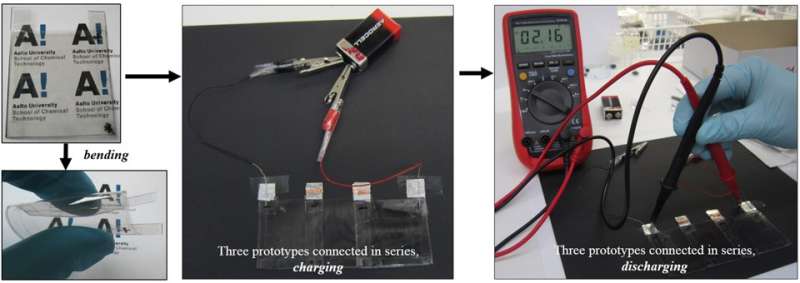May 23, 2016 feature
Transparent, flexible supercapacitors pave the way for a multitude of applications

(Phys.org)—The standard appearance of today's electronic devices as solid, black objects could one day change completely as researchers make electronic components that are transparent and flexible. Working toward this goal, researchers in a new study have developed transparent, flexible supercapacitors made of carbon nanotube films. The high-performance devices could one day be used to store energy for everything from wearable electronics to photovoltaics.
The researchers, Kanninen et al., from institutions in Finland and Russia, have published a paper on the new supercapacitors in a recent issue of Nanotechnology.
In general, supercapacitors can store several times more charge in a given volume or mass than traditional capacitors, have faster charge and discharge rates, and are very stable. Over the past few years, researchers have begun working on making supercapacitors that are transparent and flexible due to their potential use in a wide variety of applications.
"Potential applications can be roughly divided into two categories: high-aesthetic-value products, such as activity bands and smart clothes, and inherently transparent end-uses, such as displays and windows," coauthor Tanja Kallio, an associate professor at Aalto University who is currently a visiting professor at the Skolkovo Institute of Science and Technology, told Phys.org. "The latter include, for example, such future applications as smart windows for automobiles and aerospace vehicles, self-powered rolled-up displays, self-powered wearable optoelectronics, and electronic skin."
The type of supercapacitor developed here, called an electrochemical double-layer capacitor, is based on high-surface-area carbon. One prime candidate for this material is single-walled carbon nanotubes due to their combination of many appealing properties, including a large surface area, high strength, high elasticity, and the ability to withstand extremely high currents, which is essential for fast charging and discharging.
The problem so far, however, has been that the carbon nanotubes must be prepared as thin films in order to be used as electrodes in supercapacitors. Current techniques for preparing single-walled carbon nanotube thin films have drawbacks, often resulting in defected nanotubes, limited conductivity, and other performance limitations.
In the new study, the researchers demonstrated a new method to fabricate thin films made of single-walled carbon nanotubes using a one-step aerosol synthesis method. When incorporated into a supercapacitor, the thin films exhibit the highest transparency to date (92%), the highest mass specific capacitance (178 F/g), and one of the highest area specific capacitances (552 µF/cm2) compared to other carbon-based, flexible, transparent supercapacitors. The films also have a high stability, as demonstrated by the fact that their capacitance does not degrade after 10,000 charging cycles.
With these advantages, the new device illustrates the continued improvement in the development of transparent, flexible supercapacitors. In the future, the researchers plan to further improve the energy density, flexibility, and durability, and also make the supercapacitors stretchable.
"One more important characteristic to be realized and urgently expected in future electronics is the stretchability of the conductive materials and assembled electronic components," said coauthor Albert Nasibulin, a professor at the Skolkovo Institute of Science and Technology and an adjunct professor at Aalto University. "Together with Tanja, we are currently working on a new type of stretchable and transparent single-walled carbon nanotube supercapacitor. We are confident that one can create prototypes based on carbon nanotubes that might withstand 100% elongation with no performance degradation."
More information: Kanninen et al. "Transparent and flexible high-performance supercapacitors based on single-walled carbon nanotube films." Nanotechnology. DOI: 10.1088/0957-4484/27/23/235403
Journal information: Nanotechnology
© 2016 Phys.org




















